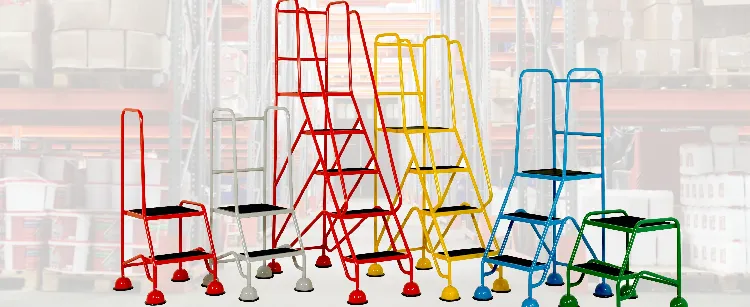When operating in a warehouse environment, the safety of employees and equipment is paramount. Warehouse steps and ladders are essential tools for accessing hard-to-reach areas, and choosing the right product involves more than just height and price considerations. It’s important to understand the key safety features that make these products reliable and secure. This guide will explore the top safety features to look for in warehouse steps and ladders, helping you to make informed choices for your workspace.
1. Durability and Construction Material
One of the most critical aspects of warehouse steps and ladders is their construction material. Durability ensures that the equipment can withstand daily use in tough environments without compromising on safety. The materials used, such as heavy-duty steel or lightweight aluminium, greatly influence the ladder’s strength, longevity, and stability.
Steel ladders are renowned for their robustness and ability to support heavier loads. They are commonly treated with powder coatings, offering resistance to rust and corrosion. In contrast, aluminium ladders, while still strong, are favoured for their lighter weight, making them easier to transport and position around the warehouse. However, they may not be as durable in extremely high-traffic or rough environments compared to steel.
Choosing the right material also depends on your specific needs. In a fast-paced warehouse where equipment is frequently moved, aluminium’s lightweight properties are beneficial. Meanwhile, in a construction or manufacturing setting where strength is paramount, steel steps or ladders might be the better choice for long-term durability.
For specialist workplaces, stainless steel might be the best choice, for ease of cleaning and a sterile type environment.

2. BSI Kitemark Certification for Safety
Another crucial safety feature is the certification of the steps or ladders. In the UK, the BSI Kitemark certification is a trusted mark of quality, ensuring that the product meets or exceeds safety standards. A product that carries the BSI Kitemark has undergone rigorous testing to ensure it’s fit for purpose, making it a key indicator when selecting safe equipment.
When choosing warehouse ladders or steps, it’s essential to check for certifications such as EN 131-7. These certifications confirm that the product has been tested for its weight capacity, design, and functionality under stress.
Our warehouse ladders at HSE Store are all from our manufacturer Redhill Manufacturing, who is the only manufacturer of these BSI approved warehouse steps.
Buying certified products is more than a matter of compliance—it’s about investing in the safety of your workforce. Non-certified products may cut corners, potentially exposing users to the risk of falls or accidents, which could have serious repercussions for both employees and employers.

3. Anti-Slip Features for Enhanced Stability
In a busy warehouse setting, workers often encounter hazardous conditions such as spills, dust, and debris. Having anti-slip features on steps and ladders is essential to prevent accidents. Anti-slip treads provide a reliable grip underfoot, reducing the chances of slipping, even when the steps are wet or dirty.
Look for ladders with non-slip rubber feet to ensure that the base stays firmly in place while in use. Additionally, step surfaces with a ribbed or grooved design offer better traction for workers ascending or descending the ladder. Some models even feature self-cleaning treads, where the design naturally sheds dirt or liquids, maintaining optimal grip throughout the day.
Choosing steps or ladders with these safety enhancements can help maintain a safe working environment, minimising the risk of falls and injuries. In many cases, these small but significant design features make the difference between an accident-prone tool and one that promotes daily operational safety.

4. Guard Rails and Handrails for Extra Support
When working at heights, even a seemingly short distance from the ground can lead to dangerous falls. That’s why it’s vital to have guard rails and handrails on warehouse steps and ladders. These additional safety measures provide extra stability and support, especially when users are carrying heavy loads or working at height for prolonged periods.
Handrails give users something to hold onto as they ascend or descend, offering peace of mind and physical support. Guard rails, particularly on platform steps, prevent workers from accidentally stepping off the edge, acting as a safety barrier. The presence of these features is crucial for ladders designed for reaching higher shelves or racks, where balance becomes more challenging.
Not only do guard rails and handrails contribute to physical safety, but they also reduce the strain and fatigue associated with using ladders or steps for extended periods. This ergonomic advantage ensures that workers can focus on their tasks without constantly worrying about maintaining balance or stability.

5. Locking Mechanisms for Mobile Steps
In many warehouses, mobility is a key requirement for ladders and steps. However, mobile equipment can pose risks if not properly secured. Locking mechanisms are designed to prevent the steps or ladder from moving unexpectedly during use. These features are particularly important for ladders on wheels, as they ensure the steps stay stationary when workers are climbing.
The locking mechanism typically involves brakes on the wheels or stabilising feet that can be engaged once the steps are in position. These simple yet effective features are crucial in preventing accidents caused by movement or instability, especially in fast-paced environments where ladders are constantly being repositioned.
Having secure, easy-to-use locking mechanisms is a safety priority in any warehouse. It provides the worker with confidence, knowing that their ladder or steps will remain steady while they focus on the task at hand. This peace of mind is invaluable in reducing potential accidents and promoting efficient workflow.


6. Load Capacity and Maximum Weight Tolerance
When selecting warehouse steps and ladders, it’s important to consider their load capacity. Overloading a ladder beyond its maximum weight tolerance can cause serious accidents. The load capacity of a ladder takes into account not only the weight of the user but also the tools, materials, and equipment they may be carrying.
For industrial environments, ladders with higher weight ratings are recommended. A safe choice is a ladder with a load capacity of at least 150 kg (330 lbs), which typically covers most warehouse requirements. However, if the ladder is being used for heavy-duty applications or by multiple users simultaneously, you may need a model with a higher capacity.
Pay attention to the manufacturer’s specifications for each ladder or step model. Always choose a product that can handle more weight than you anticipate it will regularly bear. This extra capacity builds a safety buffer into your operation, reducing the likelihood of equipment failure and associated accidents.

7. Customisable Sizes and Heights
Every warehouse has unique needs, and having access equipment that is customisable in terms of size and height is crucial for safety and efficiency. Customisation allows you to tailor the ladder or steps to the specific requirements of your workspace, ensuring that they can reach the necessary heights while maintaining safety.
Some manufacturers, like Redhill Manufacturing, offer the option to choose from a range of sizes, heights, and configurations for their ladders and steps. This flexibility is essential in warehouses with varying ceiling heights, storage layouts, and access points. A ladder that’s too short or too tall can lead to unsafe working conditions, such as overreaching or balancing precariously.
Opting for equipment that can be customised ensures that each worker has the right tool for the job, minimising the risk of accidents due to improper usage. Customisable products also offer ergonomic benefits, reducing the strain on workers by providing the ideal working height for their tasks.

8. Mobility and Manoeuvrability in Tight Spaces
In warehouse environments, space is often limited, and workers need to manoeuvre ladders and steps through narrow aisles or between storage racks. Mobility and manoeuvrability are key safety considerations, as trying to use large, cumbersome equipment in tight spaces can lead to accidents or damage to stock.
Look for lightweight steps or ladders equipped with wheels or castors for easy movement. Some models also feature pivoting wheels that make it easier to turn corners or navigate through narrow gaps. Additionally, models with a compact design ensure they can be stored easily when not in use, reducing clutter and potential tripping hazards.
Mobile steps that allow for quick repositioning save time and effort, increasing overall efficiency. At the same time, their manoeuvrability ensures that workers can place the steps exactly where they need them, reducing the risk of overstretching or using makeshift solutions, which are common causes of workplace accidents.

9. Step Trolleys for Efficient Dual-Purpose Use
Step trolleys are an innovative solution for warehouse operations that require both mobility and access. These dual-purpose tools combine the functionality of a step ladder with the transport capabilities of a trolley, making them ideal for environments where workers need to carry goods over short distances and access elevated areas.
The key safety feature of step trolleys is their stability during use. They are designed to provide a secure platform for workers to stand on, while their sturdy construction ensures that goods remain stable during transport. With built-in braking systems, step trolleys prevent any unwanted movement when in use as a ladder.
Step trolleys are also beneficial in reducing the need for multiple pieces of equipment, thereby cutting down on workplace clutter and enhancing safety. This versatile tool eliminates the risk of workers attempting to carry goods while climbing ladders, reducing the likelihood of falls or injuries.

10. Visual Markings for Safety Awareness
In a busy warehouse environment, clear visual indicators on steps and ladders are crucial for safety. Bright colours, markings, or reflective strips improve visibility, ensuring that the equipment is easily seen, even in dimly lit areas. These features not only help workers to locate the steps or ladder quickly but also serve as a constant reminder to use the equipment safely.
High-visibility markings on steps, for example, can indicate the maximum safe standing height, warning workers not to go beyond a certain point. Similarly, coloured or reflective footings can make it easier to see the base of the ladder, reducing the risk of tripping when moving around the warehouse.
Using steps and ladders with clear visual markings reinforces safety protocols and helps to create a safer working environment. These simple yet effective features can prevent accidents, ensuring that workers are aware offall hazards and guiding them toward safe ladder use.

Final Words
Choosing warehouse steps and ladders with the right safety features is vital for preventing accidents and maintaining an efficient workplace. From durable construction materials and anti-slip surfaces to guard rails and load capacities, each feature plays a crucial role in ensuring worker safety. By considering factors such as BSI certification, mobility, and customisable sizes, businesses can make informed decisions that prioritise the well-being of their employees while enhancing productivity. Investing in high-quality, safety-focused equipment is essential for any warehouse environment.
High-visibility markings on steps, for example, can indicate the maximum safe standing height, warning workers not to go beyond a certain point. Similarly, coloured or reflective footings can make it easier to see the base of the ladder, reducing the risk of tripping when moving around the warehouse.
Using steps and ladders with clear visual markings reinforces safety protocols and helps to create a safer working environment. These simple yet effective features can prevent accidents, ensuring that workers are aware offall hazards and guiding them toward safe ladder use.








